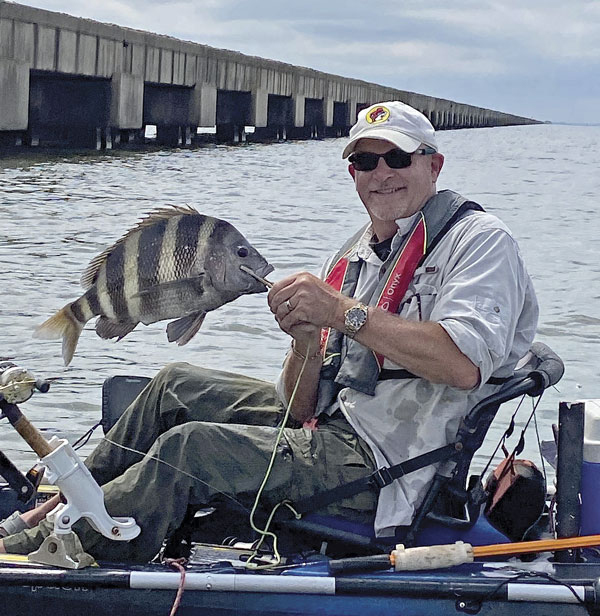 As the calendar turns to March in South Louisiana, the plethora of species that are affected by the spawn is an obvious sign that winter is over and spring is here.
As the calendar turns to March in South Louisiana, the plethora of species that are affected by the spawn is an obvious sign that winter is over and spring is here.
Among those species that are transitioning are sheepshead.
And whether you’re one who assigns these fish with the label of trash fish, or one that relishes every one added to the box, the fact remains that these fish are in the upper echelon of inshore fish when it comes to fun and table fare.
I had the chance to sit down with two gentlemen who specifically target sheepshead in both inshore and offshore waters with the intent on learning more about the migration of these delectable fish.
Mark Sagerholm of Lacombe is a self proclaimed “sheepherder,” and targets sheepshead during early March in the canals that lead to the rigs in Lake Borgne. It’s this time that Sagerholm fishes Hopedale.
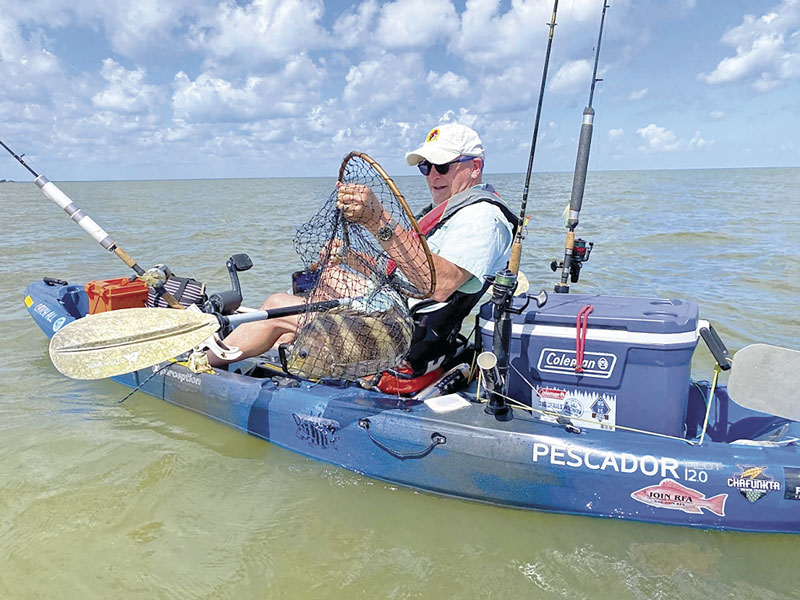
“Basically you’re looking for any canals in that area that lead to Lake Borgne,” Sagerholm said. “The main canal out of Campo’s Marina is a productive spot — there’s also several canals near the MRGO dam — there’s a cut south of Campo’s and several cuts north of there as well.”
While these spots are productive, he warns that the fish are moving through, so they’ll be there one week and gone the next.
“They’re not hanging around there — it’s like they’ve paid their toll and they’re going through,” he said.
It’s because of the migration of sheepshead through these canals that anglers are presented with the perfect opportunity to take advantage of catching loads of fish.
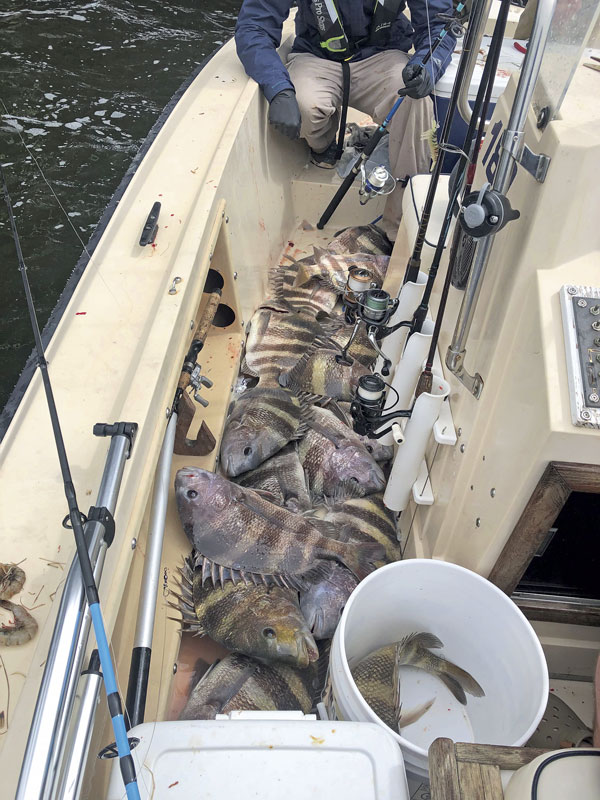
Sheepshead bonanza
While Sagerholm has been fishing Hopedale for over a decade, that wasn’t always the case. The Lacombe angler recalls a trip to the area that has him returning every year to the area. Sagerholm launched at Campo’s and headed down the cut. His plan was to target trout and redfish in Lake Borgne, however, he never made it out of Bayou Yscloskey.
“I was heading to Lake Borgne — dead-sticking market shrimp out the back of my kayak,” he said. “All of a sudden I heard the drag pull.”
Sagerholm turned around and grabbed his spinning rod, set the hook and reeled up an 18-inch sheepshead. He re-baited and tossed his line out of the back of his kayak and grabbed his baitcaster rod.
“I dropped the line straight down in the channel and felt a thump,” he said.
Sagerholm caught another sheepshead and before he could reel it in, his rod in the back bowed over.
“I was catching sheepshead one after the other,” he said. “I knew there was no size limit or daily limit so I just kept putting eating size ones in my cooler.”
Sagerholm had a 60-quart cooler bungeed down to the stern of his kayak and as he filled the cooler, the fish were popping the lid open and flipping out.
“There were many jailbreaks that day,” he said.
Sagerholm then decided to open the hatch on his kayak and started stuffing them inside the hull.
“That day was truly a sheepshead bonanza,” he said.
At the end of the day, the exhausted anger counted 62 sheepshead that ranged from 16-28 inches.
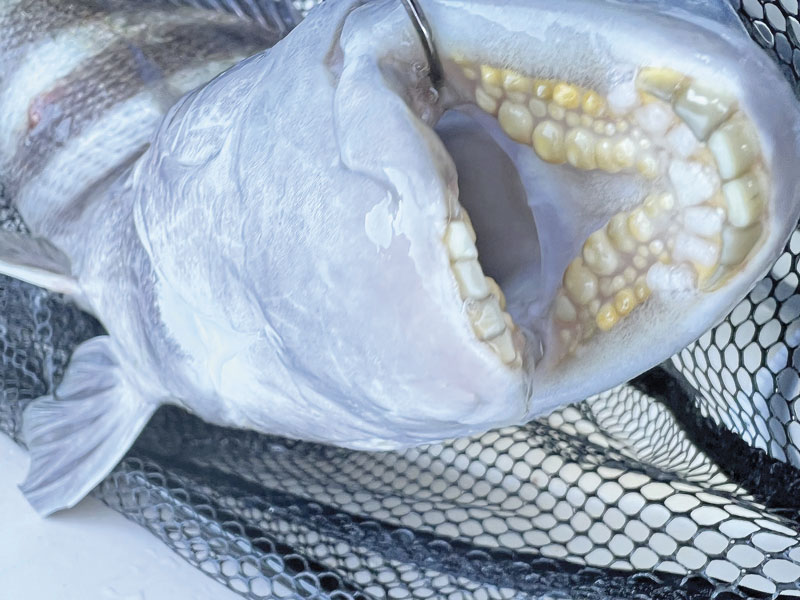
A good setup
When targeting migrating sheepshead, Sagerholm uses a baitcasting rod with 30-pound braid on a drop-shot rig. As a weight he uses a 1 oz. bank sinker and a 1/0 circle hook. The hook leg is shorter than the weight leg so the bait can’t reach the bottom and hide from predators.
On his spinning rod that he uses to dead-stick out of the back of his kayak, he uses what he calls a “Suspend-O-Rig” which is a 1/0 VMC circle hook tied onto a 2-foot 30# monofilament leader connected to a snap swivel with two small split shots clamped on just beneath the snap-swivel. Sagerholm uses a clip-on cork to keep the bait suspended just above the bottom.
When catching sheepshead, Sagerholm recommends a set of needle-nose vise-grips which he refers to as the “Jaws of Death,” which he uses on fish destined for the icebox. The tool provides a solid hold on the fish while taking the hook out with pliers.
“I’ve seen a sheepshead bite through a 2/0 hook so I don’t let my fingers go anywhere near their teeth,” he said.
Sagerholm’s preferred bait is live shrimp, but when the marinas are out of stock he’ll use market shrimp.
The Dean deal
Kevin Dean of Covington targets sheepshead in offshore waters. The 36-year-old auto body technician can recall annual trips with his father as far back as when he was eight years old.
“My dad had an 18-foot flatboat that we’d use to get out to the rigs — I remember catching sheepshead non-stop for hours,” he said. “One time we were catching so many that we started putting the sheepshead on the floorboard of the boat. When we got back to the marina my dad bought 30 pounds of ice and covered the the fish with ice for the ride home.”
Since then, Dean has continued the annual tradition with his family in March. He launches at Belle Pass in Port Fourchon. Dean has an 18-foot Bay Stealth with a 115 HP and said it’s not a very long ride to the first rig.
“It’s about a 20-minute ride if seas are below 3 feet — no more than 2 miles offshore,” he said.
While rigs are his destination, Dean said there’s no specific one that he targets.
“If they’re not at the first one, I’ll move to the next one and keep moving until I find them,” he said.
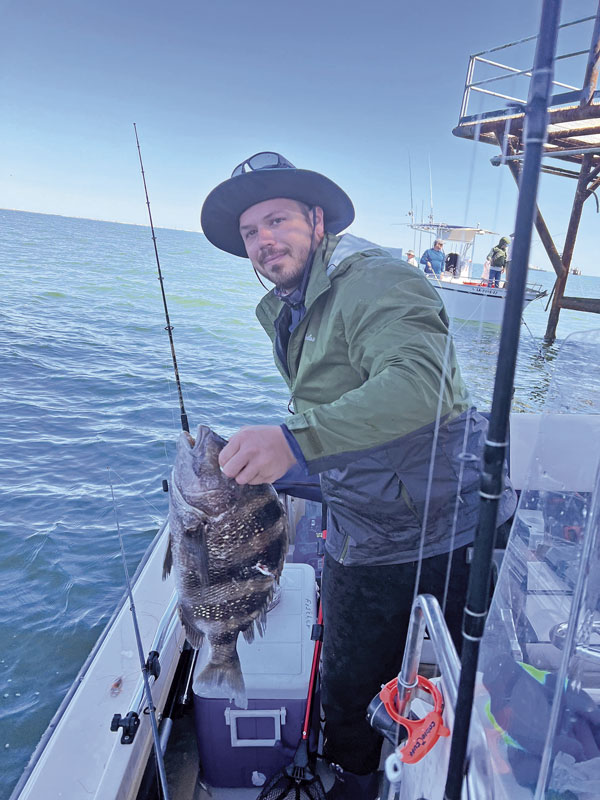
You’ll know it
Dean said it may take a few stops, but it’s obvious when you find them.
“When the sheepshead are there — you’ll know it,” he said.
The method has been working for years and Dean can even tell how thick the sheepshead are at any given rig.
“As I’m reeling the fish up, if there are four or five fish swimming next to the hooked fish, trying to get the bait out of its mouth, that tells me that there’s a bunch of fish at that rig,” he said.
Sometimes, the sheepshead are so thick that Dean can catch them without bait.
“Last year, my friend was reeling in a sheepshead next to me and I started reeling in my line so I can get out of his way,” Dean said. “I spotted three fish trailing behind his and one of them broke off and inhaled my jig head. After that we started lowering down our jig heads without shrimp and catching fish.”
It is easy to catch these fish during the spawn, and he uses an easy setup to do it. Dean uses 15 to 20-pound class rods and reels with a 30-pound monofilament leader on 20-pound line. For bait he uses market shrimp on a 4/0 jig head, but has learned a technique for keeping the shrimp on the hook. The night before, he likes to take his shrimp and pour salt over them before putting them back in the freezer. By doing this, it makes the shrimp rubbery which keeps the hook from ripping through the meat.
While the sheepshead spawn presents anglers with a fantastic opportunity to make a meat-haul, both Dean and Sagerholm stress being on-point with timing and trying to make a routine of your trips in order to fine tune peak dates in March. Additionally, as the calendar turns from March to April, anglers should see the high volume grouping of sheepshead start to thin out, making the meat-hauls harder to come by.


